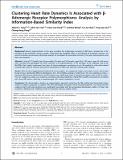| dc.contributor.author | Yang, Albert C. | |
| dc.contributor.author | Tsai, Shih-Jen | |
| dc.contributor.author | Hong, Chen-Jee | |
| dc.contributor.author | Wang, Cynthia | |
| dc.contributor.author | Chen, Tai-Jui | |
| dc.contributor.author | Liou, Ying-Jay | |
| dc.contributor.author | Gaetano, Carlo | |
| dc.contributor.author | Peng, Chung-Kang | |
| dc.date.accessioned | 2011-12-23T02:38:47Z | |
| dc.date.issued | 2011 | |
| dc.identifier.citation | Yang, Albert C., Shih-Jen Tsai, Chen-Jee Hong, Cynthia Wang, Tai-Jui Chen, Ying-Jay Liou, and Chung-Kang Peng. 2011. Clustering heart rate dynamics is associated with β-adrenergic receptor polymorphisms: Analysis by information-based similarity index. PLoS ONE 6(5): e19232. | en_US |
| dc.identifier.issn | 1932-6203 | en_US |
| dc.identifier.uri | http://nrs.harvard.edu/urn-3:HUL.InstRepos:5978625 | |
| dc.description.abstract | Background: Genetic polymorphisms in the gene encoding the β-adrenergic receptors (β -AR) have a pivotal role in the functions of the autonomic nervous system. Using heart rate variability (HRV) as an indicator of autonomic function, we present a bottom-up genotype–phenotype analysis to investigate the association between β -AR gene polymorphisms and heart rate dynamics. Methods: A total of 221 healthy Han Chinese adults (59 males and 162 females, aged 33.6610.8 years, range 19 to 63 years) were recruited and genotyped for three common β-AR polymorphisms: β\(_1\)-AR Ser49Gly, β\(_2\)-AR Arg16Gly and β\(_2\)-AR Gln27Glu. Each subject underwent two hours of electrocardiogram monitoring at rest. We applied an information-based similarity (IBS) index to measure the pairwise dissimilarity of heart rate dynamics among study subjects. Results: With the aid of agglomerative hierarchical cluster analysis, we categorized subjects into major clusters, which were found to have significantly different distributions of β\(_2\)-AR Arg16Gly genotype. Furthermore, the non-randomness index, a nonlinear HRV measure derived from the IBS method, was significantly lower in Arg16 homozygotes than in Gly16 carriers. The non-randomness index was negatively correlated with parasympathetic-related HRV variables and positively correlated with those HRV indices reflecting a sympathovagal shift toward sympathetic activity. Conclusions: We demonstrate a bottom-up categorization approach combining the IBS method and hierarchical cluster analysis to detect subgroups of subjects with HRV phenotypes associated with β-AR polymorphisms. Our results provide evidence that β\(_2\)-AR polymorphisms are significantly associated with the acceleration/deceleration pattern of heart rate oscillation, reflecting the underlying mode of autonomic nervous system control. | en_US |
| dc.language.iso | en_US | en_US |
| dc.publisher | Public Library of Science | en_US |
| dc.relation.isversionof | doi://10.1371/journal.pone.0019232 | en_US |
| dc.relation.hasversion | http://www.ncbi.nlm.nih.gov/pmc/articles/PMC3087751/pdf/ | en_US |
| dash.license | LAA | |
| dc.subject | biology | en_US |
| dc.subject | computational biology | en_US |
| dc.subject | molecular genetics | en_US |
| dc.subject | genetics | en_US |
| dc.subject | human genetics | en_US |
| dc.subject | genomics | en_US |
| dc.subject | physiogenomics | en_US |
| dc.subject | mathematics | en_US |
| dc.subject | nonlinear dynamics | en_US |
| dc.subject | medicine | en_US |
| dc.subject | cardiovascular | en_US |
| dc.subject | clinical genetics | en_US |
| dc.subject | neurology | en_US |
| dc.subject | electrophysiology | en_US |
| dc.subject | autonomic nervous system | en_US |
| dc.title | Clustering Heart Rate Dynamics Is Associated with β-Adrenergic Receptor Polymorphisms: Analysis by Information-Based Similarity Index | en_US |
| dc.type | Journal Article | en_US |
| dc.description.version | Version of Record | en_US |
| dc.relation.journal | PLoS ONE | en_US |
| dash.depositing.author | Peng, Chung-Kang | |
| dc.date.available | 2011-12-23T02:38:47Z | |
| dash.affiliation.other | HMS^Medicine- Beth Israel-Deaconess | en_US |
| dc.identifier.doi | 10.1371/journal.pone.0019232 | * |
| dash.authorsordered | false | |
| dash.contributor.affiliated | Peng, Chung-Kang | |


